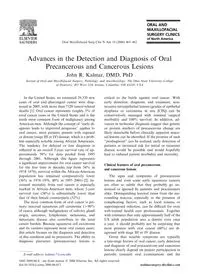
Advances in the Detection and Diag of Oral Precancerous, Cancerous Lesions [jnl article] - J. Kalmar (2006) WW PDF
Preview Advances in the Detection and Diag of Oral Precancerous, Cancerous Lesions [jnl article] - J. Kalmar (2006) WW
Advances in the Detection and Diagnosis of Oral Precancerous and Cancerous Lesions John R. Kalmar, DMD, PhD Section of Oral and Maxillofacial Surgery, Pathology, and Anesthesiology, The Ohio State University College of Dentistry, 305 West 12th Avenue, Columbus, OH 43210, USA In the United States, an estimated 29,370 new cases of oral and pharyngeal cancer were diag- nosed in 2005, with more than 7320 tumor-related deaths [1]. Oral cancer represents roughly 3% of total cancer cases in the United States and is the ninth most common form of malignancy among American men. Although the concept of ‘‘early di- agnosis leads to improved prognosis’’ applies to oral cancer, most patients present with regional or distant (stage III or IV) disease, which is a prob- lem especially notable among African Americans. The tendency for delayed or late diagnosis is reflected in an overall 5-year survival rate of ap- proximately 59% for data pooled from 1995 through 2001. Although this figure represents a significant improvement for oral cancer survival for the first time in decades (up from 54% in 1974–1976), survival within the African-American population has remained comparatively lower (36% in 1974–1976, 40% in 1995–2001) [2]. In- creased mortality from oral cancer is especially marked in African-American men, whose 5-year survival rate (34%) is substantially lower than that of their female counterparts (52%). The most common form of oral cancer is pri- mary mucosal squamous cell carcinoma (O90% of cases), although malignancies of salivary gland origin, sarcomas, lymphomas, melanoma, and metastatic disease also contribute to the total cancer burden. Because squamous cell carcinoma and its variants represent most oral cancer cases, this article focuses on the diagnosis and detection of this condition and its precursors. The ability to diagnosis precursor (precancerous) lesions is critical to the battle against oral cancer. With early detection, diagnosis, and treatment, non- invasive intraepithelial lesions (grades of epithelial dysplasia or carcinoma in situ [CIS]) can be conservatively managed with minimal surgical morbidity and 100% survival. In addition, ad- vances in molecular diagnosis suggest that genetic or protein markers of precancerous change are likely detectable before clinically apparent muco- sal lesions can be identified. If the promise of such ‘‘prediagnosis’’ can be realized, early detection of patients at increased risk for initial or recurrent disease would be possible and would hopefully lead to reduced patient morbidity and mortality. Clinical features of oral precancerous and cancerous lesions The signs and symptoms of precancerous lesions and even some early squamous cancers are often so subtle that they probably go un- noticed or ignored by patients and practitioners alike. Distinguishing lesional tissue from the sur- rounding mucosa, especially in the presence of complicating factors, such as local trauma or superimposed infection, can be difficult for even well-trained health care professionals. Together with estimates that only approximately half of the US adult population sees a dentist even once a year, it should probably not be surprising that most patients with oral cancer (60%) are di- agnosed with stage III or IV disease. Given that notable symptoms are typically a late-stage feature of oral cancer, early detection and diagnosis of oral precancerous and cancerous lesions clearly depend on patient participation in periodic (annual) oral examinations and the E-mail address:
